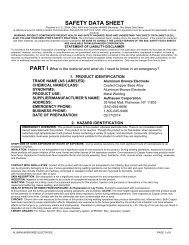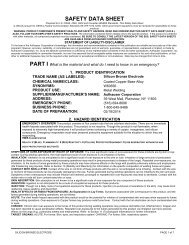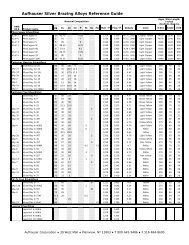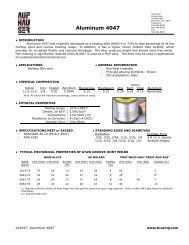MATERIAL SAFETY DATA SHEET - Aufhauser Corporation
MATERIAL SAFETY DATA SHEET - Aufhauser Corporation
MATERIAL SAFETY DATA SHEET - Aufhauser Corporation
You also want an ePaper? Increase the reach of your titles
YUMPU automatically turns print PDFs into web optimized ePapers that Google loves.
DEFINITIONS OF TERMS<br />
A large number of abbreviations and acronyms appear on a SDS. Some of these, which are commonly used, include the following:<br />
CAS #: This is the Chemical Abstract Service Number which uniquely identifies each constituent.<br />
EXPOSURE LIMITS IN AIR:<br />
ACGIH - American Conference of Governmental Industrial<br />
Hygienists, a professional association which establishes<br />
exposure limits. TLVs - Threshold Limit Value - an airborne<br />
concentration of a substance which represents conditions under<br />
which it is generally believed that nearly all workers may be<br />
repeatedly exposed without adverse effect. The duration must<br />
be considered, including the 8-hour Time Weighted Average<br />
(TWA), the 15-minute Short Term Exposure Limit, and the<br />
instantaneous Ceiling Level (C). Skin absorption effects must<br />
also be considered.<br />
OSHA - U.S. Occupational Safety and Health Administration.<br />
PELs - Permissible Exposure Limits - This exposure value<br />
means exactly the same as TLVs, except that it is enforceable<br />
by OSHA. The OSHA Permissible Exposure Limits are based in<br />
the 1989 PELs and the June, 1993 Air Contaminants Rule<br />
(Federal Register: 58: 35338-35351 and 58: 40191). Both the<br />
current PELs and the vacated PELs are indicated. The phrase,<br />
“Vacated 1989 PELs,” is placed next to the PELs which were<br />
vacated by Court Order. IDLH - Immediately Dangerous to Life<br />
and Health – This level represents a concentration from which<br />
one can escape within 30- minutes without suffering escapepreventing<br />
or permanent injury. The DFG - MAK is the Republic<br />
of Germany’s Maximum Exposure Level, similar to the U.S.<br />
PELs. NIOSH is the National Institute of Occupational Safety<br />
and Health, which is the research arm of the U.S. Occupational<br />
Safety and Health Administration (OSHA). NIOSH issues<br />
exposure guidelines called Recommended Exposure Levels<br />
(RELs). When no exposure guidelines are established, an entry<br />
of NE is made for reference.<br />
HAZARD RATINGS:<br />
HAZARDOUS <strong>MATERIAL</strong>S IDENTIFICATION SYSTEM:<br />
Health Hazard: 0 (minimal acute or chronic exposure hazard); 1<br />
(slight acute or chronic exposure hazard); 2 (moderate acute or<br />
significant chronic exposure hazard); 3 (severe acute exposure<br />
hazard; onetime overexposure can result in permanent injury<br />
and may be fatal); 4 (extreme acute exposure hazard; onetime<br />
overexposure can be fatal). Flammability Hazard: 0 (minimal<br />
hazard); 1 (materials that require substantial pre-heating before<br />
burning); 2 (combustible liquid or solids; liquids with a flash point<br />
of 38-93C [100-200F]); 3 (Class IB and IC flammable liquids<br />
with flash points below 38C [100F]); 4 (Class IA flammable<br />
liquids with flash points below 23C [73F] and boiling points<br />
below 38C [100F]. Reactivity Hazard: 0 (normally stable); 1<br />
(material that can become unstable at elevated temperatures or<br />
which can react slightly with water); 2 (materials that are<br />
unstable but do not detonate or which can react violently with<br />
water); 3 (materials that can detonate when initiated or which<br />
can react explosively with water); 4 (materials that can detonate<br />
at normal temperatures or pressures).<br />
NATIONAL FIRE PROTECTION ASSOCIATION: Health<br />
Hazard: 0 (material that on exposure under fire conditions would<br />
offer no hazard beyond that of ordinary combustible materials);<br />
1 (materials that on exposure under fire conditions could cause<br />
irritation or minor residual injury); 2 (materials that on intense or<br />
continued exposure under fire conditions could cause temporary<br />
incapacitation or possible residual injury); 3 (materials that can<br />
on short exposure could cause serious temporary or residual<br />
injury); 4 (materials that under very short exposure causes death<br />
or major residual injury). Flammability Hazard and Reactivity<br />
Hazard: Refer to definitions for “Hazardous Materials<br />
Identification System”.<br />
FLAMMABILITY LIMITS IN AIR:<br />
Much of the information related to fire and explosion is derived<br />
from the National Fire Protection Association (NFPA). Flash<br />
Point – Minimum temperature at which a liquid gives off<br />
sufficient vapors to form an ignitable mixture with air.<br />
Autoignition Temperature: The minimum temperature required to<br />
initiate combustion in air with no other source of ignition. LEL -<br />
the lowest percent of vapor in air, by volume, that will explode or<br />
ignite in the presence of an ignition source. UEL - the highest<br />
percent of vapor in air, by volume, that will explode or ignite in<br />
the presence of an ignition source.<br />
TOXICOLOGICAL INFORMATION:<br />
Human and Animal Toxicology: Possible health hazards as<br />
derived from human data, animal studies, or from the results of<br />
studies with similar compounds are presented. Definitions of<br />
some terms used in this section are: LD50 - Lethal Dose (solids<br />
& liquids) which kills 50% of the exposed animals; LC50 - Lethal<br />
Concentration (gases) which kills 50% of the exposed animals;<br />
ppm concentration expressed in parts of material per million<br />
parts of air or water; mg/m3 concentration expressed in weight<br />
of substance per volume of air; mg/kg quantity of material, by<br />
weight, administered to a test subject, based on their body<br />
weight in kg. Other measures of toxicity include TDLo, the<br />
lowest dose to cause a symptom and TCLo the lowest<br />
concentration to cause a symptom; TDo, LDLo, and LDo, or<br />
TC, TCo, LCLo, and LCo, the lowest dose (or concentration) to<br />
cause lethal or toxic effects. Cancer Information: The sources<br />
are: IARC - the International Agency for Research on Cancer;<br />
NTP – the National Toxicology Program, RTECS - the Registry<br />
of Toxic Effects of Chemical Substances, OSHA and<br />
CAL/OSHA. IARC and NTP rate chemicals on a scale of<br />
decreasing potential to cause human cancer with rankings from<br />
1 to 4. Subrankings (2A, 2B, etc.) are also used. Other<br />
Information: BEI - ACGIH Biological Exposure Indices,<br />
represent the levels of determinants which are most likely to be<br />
observed in specimens collected from a healthy worker who has<br />
been exposed to chemicals to the same extent as a worker with<br />
inhalation exposure to the TLVs. Ecological Information: EC is<br />
the effect concentration in water. BCF = Bioconcentration<br />
Factor, which is used to determine if a substance will<br />
concentrate in lifeforms which consume contaminated plant or<br />
animal matter. Coefficient of Oil/Water Distribution is<br />
represented by log Kow or logs Koc and is used to assess a<br />
substance’s behavior in the environment.<br />
REGULATORY INFORMATION:<br />
This section explains the impact of various laws and regulations<br />
on the material. U.S.: EPA is the U.S. Environmental Protection<br />
Agency. DOT is the U.S. Department of Transportation. SARA<br />
is the Superfund Amendments and Reauthorization Act. TSCA<br />
is the U.S. Toxic Substance Control Act. CERCLA (or<br />
Superfund) refers to the Comprehensive Environmental<br />
Response, Compensation, and Liability Act. Labeling is per the<br />
American National Standards Institute (ANSI Z129.1).<br />
CANADA:<br />
CEPA is the Canadian Environmental Protection Act. WHMIS is<br />
the Canadian Workplace Hazardous Materials Information<br />
System. TC is Transport Canada. DSL/NDSL are the Canadian<br />
Domestic/Non-Domestic Substances Lists. The CPR is the<br />
Canadian Product Regulations. This section also includes<br />
information on the precautionary warnings which appear on the<br />
materials package label.<br />
ER70S2, ER70S3, E70S6 PAGE 7 of 7






